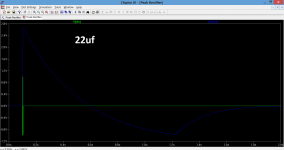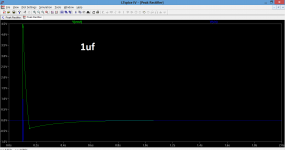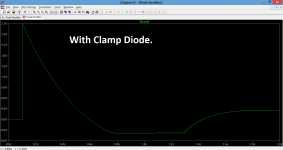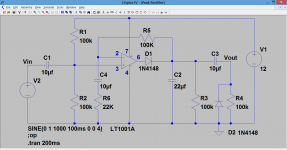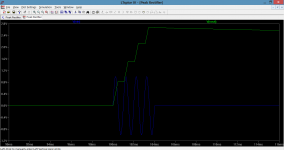I just tried the circuit in simulation again. Just try altering C2 for a start. It should all work.
(it could be worth adding a 'clamp diode' across R4 as shown here to limit any negative going transients)
(it could be worth adding a 'clamp diode' across R4 as shown here to limit any negative going transients)
Attachments
can i add you on skype or something? will be faster to discuss
On the forum like this is fine 🙂 It helps others too.
Like i have no idea what should happen if i change c2. I have no voltmeter or something.
and i did this
http://www.diyaudio.com/forums/atta...20987547-lm-3915-vu-meter-problem-circuit.png
everything seems fine but i have no idea where to connect C1. The positive in my circuit is connected to pin 3 and negative doesnt connect anywhere.. ;/ so where do i put it?
and i did this
http://www.diyaudio.com/forums/atta...20987547-lm-3915-vu-meter-problem-circuit.png
everything seems fine but i have no idea where to connect C1. The positive in my circuit is connected to pin 3 and negative doesnt connect anywhere.. ;/ so where do i put it?
You need a multimeter.
C1 is the input coupling capacitor. The 'live' audio input comes in at the left side of the cap. The ground of the audio input (the shield on the wire) goes to ground.
The markings on the opamp are confusing you. The + and - are not voltage supplies but the standard designators for the non inverting and inverting inputs. The power supply goes to pin 7 of the opamp (for a 741) and the negative supply to pin 4.
C1 is the input coupling capacitor. The 'live' audio input comes in at the left side of the cap. The ground of the audio input (the shield on the wire) goes to ground.
The markings on the opamp are confusing you. The + and - are not voltage supplies but the standard designators for the non inverting and inverting inputs. The power supply goes to pin 7 of the opamp (for a 741) and the negative supply to pin 4.
oh yeah. thats exactly what i tought. So i connect audio ground to the negative rail and postive audio to that capacitor.
And now about the capactior 3. i connect this to the pin 5 of the lm3915 but no leds are blinking at all :/
And now about the capactior 3. i connect this to the pin 5 of the lm3915 but no leds are blinking at all :/
Don't forget a wire joining the two grounds (or negative rails as you call them) of each circuit. The lm3915 and the opamp circuit need a connection between the two grounds.
If it doesn't work then you need a meter to a least check the basics of the circuit.
If it doesn't work then you need a meter to a least check the basics of the circuit.
I did everything on breadboard so i connected pin 7 to positive and pin 4 of the opam to negative so i though my vu meter and opamp are connected together?
You need some means of measuring and confirming what is going on. A multimeter (DVM) is the minimum for any electronic work. You can't do it without.
i could be wrong but i think that the OP complaint is that he's getting dot mode and not a bar graph display if pin 9 on the LM 3915 is not tied to V+ he would be in dot mode with rapidly blinking/shifting states and on a breadboard that's a likelyhood that only a meter can confirm.
hmm. when i connect audio to pin 5 of the lm3915 circuit works but only 5 leds glowing... after i connect my ping 5 to the C3 and C1 to the audio circuits stop working at all ;/
qois?
if your touching pin 5 with no reference to ground you see 5 leds light up?but after you connect your ground the audio dies?(how are you monitoring that to tell?)
if your touching pin 5 with no reference to ground you see 5 leds light up?but after you connect your ground the audio dies?(how are you monitoring that to tell?)
well i meant to say that if i run a vumeter simply without opamp where pin 5 connects to audio everything works, but only 5-6 leds are glowing to music. After i connect my opmap to the circuit everything stops working
So you need to prove the opamp circuit. The pictures I posted earlier today show the output of the opamp circuit when fed with a just 4 cycles of an input signal. Here it is in detail. 1 volt peak at the input, and that is rectified, amplified and held. You can see the output (green trace) climbs to nearly 2.8 volts and then falls away slowly. This is with a 22uf cap for C2 to hold the voltage for a bit longer.
It should all work if constructed correctly.
It should all work if constructed correctly.
Attachments
so without a meter how can you tell if the voltage reference is allowing for the input to cause full scale deflection?
i dont have any idea but all connections seems correct for me;/ idk i will have to test it with multimeter
Hehe i have redone my opamp circuit and now when i connect audio to that C1 led glows the same ;/ still 5 😀 if i change my capacitors i can see if something changs and if the scheme is correcT?
- Status
- Not open for further replies.
- Home
- General Interest
- Everything Else
- lm 3915 vu meter problem.
